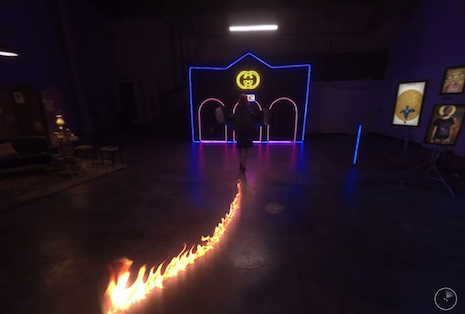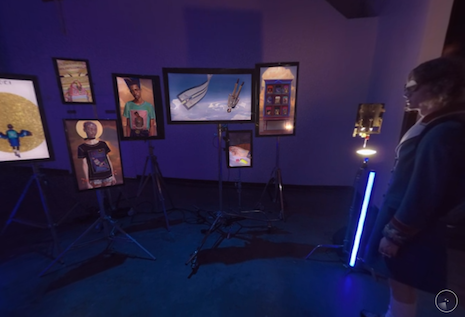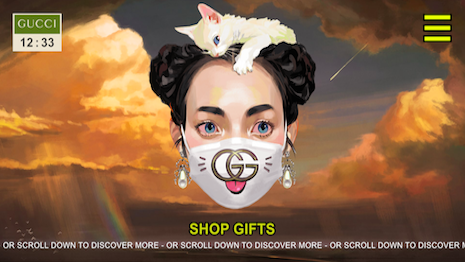Kering-owned Gucci is using a technology-driven approach to raise awareness for its 2017 gifting catalog through placement on New York Times’ digital edition.
Gucci has made digital its main focus for this year’s gifting season with efforts ranging from peer-to-peer communications to out-of-home displays and scannable store windows. The latest addition to Gucci’s gifting initiative leverages virtual reality video to explore its creative partnership with Spanish artist Ignasi Monreal.
"Consumers are driven to innovation," said Sam Ewen, director, new business at Fake Love, Brooklyn, NY. "There is a distinct interest in knowing and understanding how our world is changing and how they can be a part of it.
"Three hundred sixty [degree] video and VR allow the user to immerse themselves in a creative storytelling format," he said. "It creates a richer and more engaged experience and allows them some control as to where to focus their attention.
"As the creators of the content get better, the users are more willing to come and take the journey with us."
Take a look around
For the holidays, Gucci renewed its partnership with Mr. Monreal following a collaboration on the brand’s cruise 2018 runway show. Mr. Monreal then putting his touch on Gucci’s Gift Giving book.
The digitally created artwork in the catalog is inspired by the Greek myth of Icarus.
“Icarus fascinates me because of his story, which could be read a bit like a mantra, I guess,” said Mr. Monreal in a statement. “If you fly too close to the sun, you're going to get burned. If you fly too low, you're going to drown in the sea.
“It feels quite bluntly obvious, but I find it quite timeless, and reassuring. You have to find the middle point to land on the other side,” he said. “It’s not a cosmic science, just a tricky human condition. Icarus himself is a very romantic character and of course symbolic of everything young and pretty. Very East London” (see story).

Still from Gucci's virtual reality video for its gifting 2017 campaign. Image credit: Gucci
Mr. Monreal’s statement about Icarus’ shared characteristics with East London serves as the basis of the Gucci’s project launched in partnership with NYT’s T Brand Studio and Fake Love, a Brooklyn-based experiential agency dedicated to “creative futurism.”
Gucci’s sponsored content appears on the New York Times’ Web site as a virtual reality video banner advertisement that takes viewers on a 360-degree tour of Mr. Monreal’s actual London apartment.
The virtual reality video is narrated by Mr. Monreal who shares with viewers that his mother told him myths before he could fully grasp their moral foundations. Mr. Monreal also explains that moving to London has provided him with a new visual language for his art.
As the nearly three minute video continues, viewers can take a look around the warehouse-like apartment to see what inspired Mr. Monreal for his collaborative collection with Gucci.
Since he uses his apartment as studio space, Mr. Monreal is always amid his inspirations and does not have a divide between what is work and what is home.

Still from Gucci's virtual reality video for its gifting 2017 campaign. Image credit: Gucci
Below the virtual reality video player viewers can click the “learn more” prompt to be redirected to Gucci’s Web site.
Gucci’s Web site includes an interactive takeover by Mr. Monreal, which includes a real-time clock and temperature reading as well as artwork that follows consumers’ movements. A menu bar allows consumers to browse gifts by men’s, women’s, children’s wear and home decor.
"Without speaking on behalf of [Gucci], we have found when dealing with luxury brands it is imperative to bring the buyer into the world of the brand," Fake Love's Mr. Ewen said.
"The brand represents how they want to see themselves - fashion forward, daring, creative and confident," he said. "Immersive experiences let the user identify with the ethos and imagination of a brand and then make a decision of whether it truly reflects their own view of themselves."
The virtual reality video produced for Gucci in collaboration with T Brand Studio and Fake Love can be viewed on the New York Times' Web site. Please click here to view.
360-degree effectiveness
Across sectors, marketers are trying their hands at integrating virtual reality, 360-degree video content into their strategies.
For example, Condé Nast-owned Vogue magazine leveraged virtual reality technology to give consumers an immersive tour of some of the fashion industry’s most coveted wardrobes.
Together with Google's Daydream virtual reality platform, Condé Nast Entertainment and Vogue snuck a peek into a handful of supermodels’ closets in 360-degree films. Publications, including Vogue, are increasingly leveraging digital media to provide content that extends their brands further than the page (see story).
High-level, technology-driven content concepts have proven effective in speaking to luxury’s digital audiences.
"Intelligent experience design uses the tactics and tools that the audience wants," Fake Love's Mr. Ewen said. "Right now those are about giving control and focus over to the viewer, giving them opportunities to experience the brand the way they want to.
"These types of triggers bring the user deeper into the narrative and are natural to the evolution of the medium," he said.
{"ct":"vIcSkAHD5JdNbPMz\/Ygn\/jAGkqPlBY6tijXNi\/hHd+wPTIeTdGy7Ec1z3v\/r3TQlpsPG0ujs38slCYKsqQ\/G843Nvr8E+jeCZOxc2H8mi3wPmKyeouDXpderOhMU37LB3F8qPyssipDwwHvZ+f+EpbageIZtNfPw8oy2GS\/BmPSSamO\/zd\/KBYahGK4q8KJH2zrTIvGPL+JRdekbbKK5jan+20Tm9fd953vvbBhqqIllbisZ63TdNNGmuy7nBZQUDN7au5j0Tf2ZXNO9fwj\/Zc\/IYRMkkyYcdPLw5uaTjeAHuOzJj1KFaUKOpFH+RAwP9SpTdU\/CgNjewdxkHFC9PMJi\/xv95UM9fIzR+s0Pa6mMMTk9PHPcB3ugbptEvp99OVjZMfzQSBcif0dDuUnxfQL0aY3yemHGMoGern8\/SqLoh9RdemZU1GogQ6YO1WS\/2jRFT8WjpZ3PcxGLCBRRguUj80J6bwQ3E+dC38NKKadvFntJRwevIIEwzww2+TfZFsuEJwGfV+sQeb7vgQ9iDESrrmjDk1gz\/UJSSHamsoLwMhs+OTPqBBDSP3Pbbnuoj9ljgBecXEVLCEFm1taIae8ZrptOHqs\/wgdSab5PHnb8veGmb6aW1e4BXA6ysRNH4JxALzeXyLQGs9McM6vgSG\/lQ9E6w6gOGt+sAQDHJ2hXlAh+1tFEudHbGWr8lz1TSDE5itlrWnzVSGgMYGHKdNtz7BM8CNuyMeOUbceI\/op8S4\/8OYUf9i598fmh1SBknFcsaNsWAXDm5sGxcehv3Al7csa4Xygf1vwgnIMpLXjy9Ge2CUjHTeEzYrr6DrVA4b2eInKj2r5DW\/Knsl5icuguQkHUKmAswj8t9DGvESYkfAAncrsBKDto4m9dfQgHa+Eym3LR292w0n8h2kPdoF8Vok7ash7LCHoa46tmhweFu77hiCKzdrwb52M5ssuL0ZOEeTbFSG0wVR6PrgxZ7PtVXvWMtMrBilDbBtbAUfHfkSKrWDoZbo3S4hR7bgCK2Ycy4SCwf5VdntHk62+YN8nMVBfRXHPymm3nliMYxOclqNssLO8n0\/1ztlFvBxoIrdkMs\/1tTzfDz9za0bmUH1JRasmXwoPchLM5ZmyHhXZ5AB6fjW\/76ZSCZFAOero1Ym+cCX27kYIInbJC24rEj6apTcg\/GTsgknfFvw1PoEJhuKhV+mGYhjji\/HndwX8k3\/nffB7l+TAtR5ekHOPu2tQzisQB9MNNoxSBVVbeL890lwCog+Yg2g1avcyaC5Eu3uzwuz7tgohhIUS\/SSBnCNoGFix0ojO7tTnTfMcZXNQsg8eZ2UfJ1jOrkD7\/Iaw7bj+grTdWmA\/HDnFks40mC8CSLu5PHydii6huyEFnOrY6H9IHOrf666K660YYLvBVP23ZiF2D0bpMrfa3pVW4JzIPfGsE9UbC58nAVqnlZ1KBTzLbhaRhHqU2dHXkwPytJLGY9vrbRlau\/IQK5Mn4Pyb4X6D5YdPXoBSNAUV+bF0puWhxfzZn0d8k6p7rIHKnzMlSCvT6pyhuP\/wAzjV5IKqxRMxayEUWyl\/XtM\/q6w8SR\/JVuM7ATTRY0HWxdloMZnt91dUDyXpNd2dc5ohL6pN5+DvyakGsCGif0tEq4pVTK6s9JZVgqBBTpTC8cDgPdh3aOV++DMyt69b5Fi\/oQy\/49\/lvfeVanM6kgU7ygccmTVCqG7rs\/2fOkxExnVpZ7mNSkkZ0WpRufhnN1cRsdorFDOQa6NNe7Ii+O1ogWlM7VomCxJUk8wjMkgYnw8h0tlxGnkbH7w\/4Q19uDfIGlVHrNN8oNEBwnPLoMbgtqoUX+7hITGPNn6he+mWgPo41oSQmhMwvheH\/M7E0BQGBJmxRox\/DMhoQ2pBJ2lJG2bOkYWv+NbKXV1GvPsbo7dqbhbaSAVzVvgln\/X8e\/u0krqjfF9oMYkQH9NN88bacx1uoalOv84S3vqtsCpb\/iPLtFEsmRsCXcph3yuGBLlyR9GZq5doDPhJVzlCFEecpRrCmtCBE3Hq8CPtWWPh\/aNQpTwb1f3\/KfnQBP0i5dZNo9wRFEZY6fOoksexlAhxfSpA95kbwskERHibP7vTtZfMODyZ7g6h0JKEwnmzQvympTWFI+LZ+I4mCSUUcOPtNE2fmEJ7BTDaJAVs\/+Yw1NGaSVeOSVMbmneZCeggS37asxrSMDizqL4S0MlHe\/Gn\/RPD6i9p3pU0LG0fPgIGB3CWYxr0CfJ2dSs5s3mhh1dHa8zAyV9ZnJDhE8p8VZL2DxOzF1hRMIzTD4LPqD3U6NhlyaFc2mAIIWfGBKttRrg7gymYNU+ZJPvLlw1HTf3C895C9A7K+fTFdyNFxUzWXGhSwRIbQhmYA97NUQ0euxqrRyrVNnVcy2ufsy3Rgea+XSAMRgPv4rNR2GUt4j8pr78TO3SRpUW8DhNrb1P9InDrNjsLcHulR+vx\/\/dU4MYTKOu2n2PR\/Sb6wKubFhtafTTC\/RdTk385oHmXN6Javo1F3KIyH5c9VL9FMH\/Fm\/97tdLKVo3FSBUdDl9SsCCREWg6dY8i21uMMFj2q8imXZEwWV72JyUkpech5lhP\/iTpHSiL2Q7YvUWZSgoNvC9XWymvYjT7uuD5J5D8+QrUyOMLv0hXtjrgUA6XACRqEey9gd194gCJnRkOgxLEpaYQcxJEU9TLOu0H9s49pi\/WRbg8\/BVU7ubmrPsTzre8JNd6jjVaBQEApdg0+qSKD1+y3L3aOT8G+h8h7s0YRJONbFGfZh7HEyeWL\/6vZVoS1mo+33me6wotPWIMuPTC\/i6DAi0mj+jRpIzW7\/6QL2JkOwAZ0XZv6cr6Av3LEunvtCHi1poXkAR2HnoMsiXDY\/J2UeaHP7tTWZKdWU+kh9DFhf2685Ybqw59FdkGXwIIFDVs4rRpzln08Ir3sKX2Oihz4Kbw4gJcocDFIM165TjYWzHBpO4vyTvxXmX3\/fxqnRUD5dpq4Xyynwiq7qEO5gB6aECDnNE2xVWG4t7\/WkfMkSoEwb\/zIRTtCA0IjGt6w45MPWx5h3tCmSPqq6PYRrovBO7+fXaXxwidWtbUbghB54FSNfl71R3n1VRKpRRuMmm0YSSzvEgQ+ukVtem\/TDwgqDADtrTfhgNnWs4dxJK0jeqMQfm67ponb6fixt0QNf\/7VB7Nh+lsNGH4hlJvBtxHCB5oYM6TuUH8jpgWKJMda3tuT4tUk7c4GLAsqnILc15plyXabeixvKvJnxPKuEqcKVne1sslOI\/u90ek72Eya6sg13osABBsIPdSfJwQ6giCsdQgL+uaoe3ohW3kGI2LZlZF5P6GYvVqwrzCWAIkL2zHQucXSj63NRludTNQO6HMigNakBitAt2+QBvqWzzgqstsw3tUbWT2ioZSJj+b0BefuBUgvPh0NDxEwEHudnT\/zTf4n1jXZR6x6jJHqiWbXwMzZ6LOr91nXyUV96lIKHIsal\/oTT3hT0IyuWh\/2GVdh1KsqTa3TyGycn3m2qiFYxuAVVes4grKAjIdIIbJe0oTyEkHPUwdfk2TVQBTQv720HdJ9ARPmW3tk3KOcTGa1Q+fWZ4zyT8NGs7hJvqMSoZDSS3NO00sIDYhGVN1ZrmW7K2aDDCleRGZ8f0j3nH6p3jNY9sOc85UGCj+82IwA\/1Wtcc4BiqhDRfAWLkB3IHuTQxgyK9J\/xAXmIuuGlr5gHnEgENm5mD1Q648ngR13IGqmMXpvyleIBaxeLWFtroa49bH\/oaMd066Ys2u0Hh75FwK3VaNhG8NU7flRaSX\/ajTXeyfdxY1WBEfnggFTloxC1VsD6el+L+\/OhoLA4mklmFjddTQrxzH7EOOiHxdxn\/SWZwVMbI1VYnb0QsxQPcioLgu\/jbGa6\/ZXRtAUOyITjTEjmNKohr9beijU5jNqXZgDr+8YFb4bFux7Cr\/AV6SVosCRph\/j08X74AYfBpjOoCKAD9XCI6OxnbytLFD0MwG64aKfttMc2s6WunnUKphTqPX0xAHmBfvtaFF4CzQnrVB07axmmgk6NucnXQn5IKOrPlKBj9zO52v6Uo02rUaTeEQQTsRx9QDfe08GC\/s68qLr6bkKJ\/nHMLPHnDPK8\/ivEib3ZLNzqUlVHJoSMIRe+TsgPWRPBfMnvm11uaey9HiwL8iIhsFNOTL9I+2WU5NqVhzDgL18mgJB9OfI4KrtpzNUBPjFMdOOFmAgXT4FZE\/CrtgB369hw922lmscr3k9WSWz3SSmHxoN3pdlGD\/QCBdwCNcRbkUHhI0\/FrmVXhOsOZNAv9DKx1Ho9UMBCa9FqzUf\/u7zHfnk4VMP0BfKRlGKGmFoc1u+oIWkn9RZLJSv2Q5Yo+XTJl0urr5DBxEcGn4oUZh3zpFVkjHOvGsdriB4f0ox\/\/\/WW1XeIxELSSLfkZqpULAP1cthkXozvVufoSzEaIrXgHTAI8gV98J1wooQUdDw\/8qrKoVJuWaixDMFu6F4SfJl+YxejVBSZUWUL4tGOKC\/PxpjY32UyR\/oi0SLnV\/BLr1LUq7GOgqUzppy0\/n4SqAPKF\/pP2pU0lLdpjVgTbUDKABjVdS+sFju96GIQXRD1KJ\/9h4xeUZyVRyaVvleRGbj5q2iCHEScXMMYF7sR7G7tMfy\/xxcfP1rWhzfRZKnUsohWuRrfFHFh9255v3sE+5Kcn11XFTujYW\/9OGBTp1sVxmL51UewDibcnKj1TVuzPqWtB+2VULqcqqYbzfyyhisHdTGMcBTvvZkF0L0J92\/heJfI0+FEg3xgDUfzPsEAjGIFnqcdTXMmitRL+OApnqkH24r54SZQaaAIco4Hv8nemIQKLAay5WEByG3jkaz6qEdByUChbCibzGNCdT\/tqfFDzgVDNAAHR8PEWXyhwAWQbRbPVD5TSl9FptM81WqrtJxet3g5DyamaiUWp2ydwJBApU1fbDHcGlkgVTJQZDHH8E0rg765JMTVp+LI9HF9k3nKKle3Vxf6+sc+GwhaQcSGDtefAeZCeqhzvstCelL\/tQsVM4PR4WYvjjmpDI4DvfnDMBHpTbRSJy9D020DcIT36j4Y5ks6YP0LcZFjV2Gsf3UKXaEqMLWJUnu0TZVqw3YejzNbdnHf9Br6JipHOZqXt\/xxxhrxRBzcpg8YL0RAdD6X7IVZmOziyoO68DaisWxDn14OJLOYVYGx5zrL4aorcWhUeU0gEWrzpDHcYLvxD2nDdxvqkydHQoh7FtHSVY9nMgbZ4KV27aXH0Z3OQdIHZEEyOSdV4HRlPqlzXy\/KqPcsYAqhesG0Luujick0k953DvyqiyEgh2MOGWn\/KJxfiJ3FxpNqWJqqQCRigrF444KxlLIEOvkmYnFqzMiLT+JumzbMBfCyJsua0eKhAtSYUtR4\/2a72AH9ndG7sWF8tuujjaJl3u6RCXRc8dBByV\/9GrQwEhWObEtVDk1PmQvjtHYuOUeiEbPPuZC2bFwHo37jqgq2II8YtP9ze4TEoXcdwO3oqysR\/z6gyqtMidu51sJ+CPLRKL\/FUer\/NzDOCwCe8aZP1NT+LbfKDvtjFbucmO6hV21cRFNtoDyKRmXAYcgGNZKcYLyZaCPkZraUqgyiRD1CUKcnzcwkc9mv1s3\/wJO\/obK+wGHunul0xBOFFrSa9W8PWLdPZSa1OdBdBc+tYTMFVL7ezNmPm8sXh9W9weEsziRT3bGGlF5lHlChf5\/JWx+tEeN25PA3A7Nh2f\/zAqnWenUkH+ANiLh7S3Ph5S2YJWlYeXEiRU4yz7LoeWhiXD9In4frBYu\/KQVnnDKRglruRparbRGHoo3VULEQQwJkkIPHJF\/szcQULcECu0zHjgy7gc+iYHRcltPABXnHPagfelXyBkXxiFyJ3uSu5ijDwQVexdAFbo3BydpRXxmSKxLOt4lSQoU8B4ybK6qBtycCZ0mTclfc6nm+ZkGT+qJdakakmqnWSRfAwQx0Lv8xrdoYVMUe6oXUgtcQDGiHV0H0B33V10VGzh8BxxMoGSFn5yuOsbIy+JcPoq7HQ7K43aZjj5sx+yjyx+wRLXTs+oYrejX5PEuYTDv2SEzwN9kqW\/YFTOU44US\/PT6rBgGKKYTRkUlTw+9F9xNNZaTKzCqIxAsJaWJtPqsqHpOQZL+B+lh2zfaHfoaz78X6DnD2LNOlev\/OQGMgjW\/qG\/tq6r4DIIEXeR7dYmMjovv0l+WxRORqO8mWf4CaRg5QkBd3fiU7Mv+D6krPQ6SdMkpgUIL44zDl50n\/M+ueJMOiH5X\/rtK0ETHfTgO7dyckigHjFZ3hBGxXZt\/Pa0Wk+hNsJPYIo8HxmybXGTArpIzi\/b0HzNEDz2iO4ZNB1IAQJd5p2HfkZ6tawzsfC1gx6UXiOt117fSBQu7M0zNCwJqEXQw+4SIWn4dgWyFxYTKkjhRy6Gb0hJ3ktSbSRPEtAO5xC8z0OWg7Jur2uBZayIJUQrdKWcihlHmNXxMcf9mw59lBXc8EeZspX7yTgAYU82rsf7otYD9BgZGtoSip7yuqUCkVNwNDEYeVit5Isi7mhMpCT85miiiGWKbThG3hw5iyVcHckkWEFTW41qFlCWmhuZYSZfrC4BkvViTIMXWyyigoFVfL18W\/OyJw5t0gZ38CazEfnbGkwY4iCkPBL\/1iP7lDq1EbhoeBU0zM59P4Xy34CT4u+1zES7rk6co8kgGDkHmQ1OjVViMEXZpDCMRIeUWO8sTAVtRrRdKdGCRpbjuWNOl5dJtSB4bCf+sJqbg8YEamLw6P7N6qu7hHWLFzPIFb17VO7rrthaQhvKlI1lf0erT0yQJzyLScPcMTgJz\/XdO1T7Vk0IG0+z6Td1bQ2I1lMTxG8dDAuNaFKL7LH5P9fKLzhqOGGr8MPdGVaq89pGzzOfeffTtwVSRfgI5plqy\/0Oi3hxkxPgWjSzx7CzhGwu95MmmF2+Zs0qRLviCfSjmUE8HnOsErxP27ZmTnf1jZeGlOSGs5ciZy9kGICwkEfh\/Em6HHdZXH1vLYLV+8KryJnc6Li4cBQn8skNyUdp1lgp9tNkJzDIns5I6V06jEvQvZqRWgQYmYGyAe6nz1EcgBbaHOIEoQN6adikokM9v9EYV9PhJBsGPRkUSdkLTGtQvWsvmi3g7IAmfhmPfjCO+T9UAaZgx2SkdzFI9o3MbBWoYofltTBmZT25fCwyOPVoc+mAhsQKIwlSJNIpgEh36HWQGiHg5V\/\/fzqv\/+301Gqoopj1Tfhq3ghEt4DAq9JLP8+6zuGlyVLt0bGukzPdSoz\/LLhqmK9yK6ti8B5aMVbOhTU+lebMUox+zukZUnFSlLlTsEXAv1\/Y\/xmcfsxnsBlLMcpjxQ0ZU8qOyku50cNX+PQYHK1UKdOOzVwcVlGrbsRjF+aCicuspu6XJYjuIwwSKVTb+16osHi8xHFuxzW+xbI8j5OMW0VTbfqiJTRQsLe9KDTRS1G8TKuLUw3WqgUalMGTZMpPnkoyjqH5qoYw2undetAwPCcioGJOvUZTmm6bHWqcRLDlbjc2AO70moA5EZxu3vlFOdtKsYGYev347ksHrSH3A3J9aMeM8XKk\/ny8ywCOEJ9AJnfOUwxiPp0G7jIpX+jzr7NcYnDtkBG7I+gGtDuwTHo8FfPi8LOeUgF3sxEtfPwMnIEIyGCp6XxD8rFgt+\/iW8D16GgLYQI8M0O2URLOm1cUb2vQUSEEQ5tOoj4mXO3ardws7LPTHWRUmo7\/OIGUWfbgBaiOaIwTaNAdx32KfiZX\/oT0SCcUwgV5Of17KuWbboLG4OXURyKPlvaIlootXgok0Zw51L1V6HHMzbiyxzqTvJNHqORkhrN7HM4JPnoaRDZhr5f\/LPe0lySGserQhSaGMt0atGT6BVWN9i+ECk5LyHaWhqFr1m\/hu7YqA6aUeAprgvXK7OGq+rrFQ+E6SUqeuMfTfwEMD63LXgMf+k1iymlotHa5zyQ77u6FBFyEa8GAA\/BBY1r7DEKc81az2fWAJ3GFJaKkRdNJywqMjmrjRSQuBN8LBEG2VM98JjCVbnPF3m859D951L7NxpDqh51C86x18uDcgzJsgLiXhRGcpAAbRlqmDL1J8TliQ\/ccml2bS1Jj5LUxMVtJwBBQ6\/QyyvJv1tI4AxRG5VXkwJTRDwTBJrsEMxSSJs5G0ewynWuhyiLNkdmCj9tpGUVBoC3vzdM2hL\/lcMnyRoYQpci7LDY5r6W1l4CIuRZHKOaEA7eFpFV6pRNuYVjIRfm3aFwhjsklcd0nxbQI1sUfgjLstKFV7CDRH5ezrwNPpIzE1LK2ITY4YjEZ7PpIeZNBf7gzibhPE7GqVEnEBHr4XFoMhny72l3cXlyaSsrp8v1sQi9rsh6y17Yxc6Cb3C9Gy+bbKFrdd6yXRrDgnAryOZCS7tPgUG\/V8jXmXNc+CzIhUnW0tMjoT9Dowxd6F4pIgkijgOMEPowUUvmmiVvJa9XgMHhnESAXLqIMafutZErgN47LItBWjoe0+wzjZ\/sSSXvPP08\/yYObCuP0kjiDF9V\/5MhTSrxXXlR66vA9saCoto24K2dzdNkvFRjiIW9yD1kMxAerGsUShgJSbkrMnTDIObS43gHYD71KbnLsGztj+JCOs7nRATOpXnGA6rfnIiAE71EdakjFZ9iKH\/6lNzQc0+A9R5ofhQB9pl2tsamcJyTKtiRG3I4MguU1Z1moqR093E3ifWxW89mK5RH6XqrQm+4rSZZFunI4NOP0\/+0yEOnt4CIvgNqSxNcX1EyjH+9vuE9FJZLB71qzH8z2ajCOSdiE2t+eb2P\/dlmfLcpFtMkllm8CF07tipSssdQ63\/6PFRdvVI9RIgeekvsqqE0KrCf+JcAaSbhpjvkaLF57s1ZIZwgJtftcjmpeyBjRaSkJ8Ev2eu7c\/WcTOAXOhTNc8KTTJu7i3\/Z9eDE9aeoro77A8HfbLK4+MtTq92i6MxGjqvWsW82Xl2H4pw1ra8lEUISZfgYXbjHFyrSalL7Dza+XDaALknvaZvM2CbL1ileHgGAawV3DMOK2d+GTOYo8wmZPHRRpf3OP7eDiOwuAPTWtDB8yJW7mF9MhUIXu9NBcD4XOVYAzPt10bcEv5kHoWe\/wWqNTYHxGmgg4MuQ33GE55EX6gWNp2\/653ljIsYHYujGSvf\/nJjZofjoXOzksWPYQP8pE6s\/XV3ZWEqzzidCvM46DpOv9pbCWSZm0FbMrJ7KY787sQCatWJPOs\/i3QeV7asVx\/iN\/D0XvGXTamNvIvVqgRigqz5iLS9zhLl7mivFkqnP\/KbUZhMQn6yjc6Au8MkMrek1grLxTHm3MBQZtHYaMT31BeL2KQln2vSIBTzXkxmp\/JMPKjqenfHIP0MXhqpDCpM0KPgHUZjBjXQS+yJLL22KROWlcgYaxX25vX7IktdqIDqr7BEDpf3lFDngIPKUHcq3dYzWNA9UVEkLTUeaGm6fyR+lPiOAanWRQNyU1kkWb5tnwwcWd0Laqt7f1Nf5n6qw5zcu8IEfXsT9PrJq6CxS1GHqNGyt8GUMPPCjH5xFgaKfx1PweKliiqJeOZ3V6q16wvuT2jGcQUy9SbvRCI0T+xvpzx63Rkhsol6\/dwtxzWXHvuXhD87x34u\/roNF9\/fywrlds6UIIUj7+oUY6U5GJ+HjmZ7XfFu6HHZGjtmVuz2ZlvHqb4wTOmiumh\/xC1l\/64mH79CULzz1YfI1DrHnAHiqTsAave1Z1bOlhu7ZB\/NSodlZaYyIN1mWVHPObeMtpRdQ==","iv":"9e3be9a282c100c77cbc40a218bc5f42","s":"736efa5a47d51e71"}

 Ignasi Monreal's artwork appears on Gucci's gifting Web site. Image credit: Gucci
Ignasi Monreal's artwork appears on Gucci's gifting Web site. Image credit: Gucci